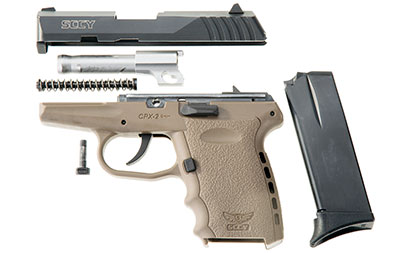
Most gun factories I have toured over the years run to the grubby side. That’s because it’s hard to be spotlessly clean when you are running old, open machines, and with any gun company that’s been in business for a while (which is most of them), that’s the case. One I toured had broaches that were World War I surplus, and the operators were constantly covered with oil. This factory didn’t even win for oldest methods—that title goes to the gunmaker in Russia that was something out of medieval times, pouring sand castings on the floor with metal melted on an open fire pit. This is not a criticism of gun factories; it’s a fact of life. Machining is a dirty business. Most of the “clean” factories will still leave your shoes sticky and your hands dirty after a tour.
Therefore, I was a bit surprised when the most recent factory I visited was clean enough to pass for a cafeteria. One reason? Modern machines. Newer CNC machines are enclosed in cabinets, so the cutting and cooling oils and solvents can’t splash out. Unlike in most gun factories, new CNC machines were all I saw at the SCCY (pronounced “sky”) pistol factory in Daytona Beach, FL. Why? Mostly because it’s a relatively new factory. Many gunmakers have decades—in some cases, centuries—of history. Although the SCCY pistol was developed in 1998, the current factory opened in 2010, and as a result, I have socks older than most of the machines the company runs to make its guns.

Another reason for this modern approach is SCCY’s leadership, led by owner Joe Roebuck. He is a tool and die maker and an engineer. Roebuck designed the tooling and manufacturing processes and oversees production. He once owned a company that made heart stents, so he has experience paying careful attention to detail, which is evident in the cleanliness and efficacy of his manufacturing facility.

It also shows in the handgun. Roebuck came into the gun business with a clean slate. He didn’t have any old, pre-conceived notions and he didn’t have any old, existing machines that had to be used. So, he could design the manufacturing process around the best options, rather than the existing machines already on the floor. Of course, the odyssey wasn’t without some stumbles along the way. Roebuck started with the idea of using the process of metal-injection-molding (MIM) for the slides and other parts. That’s what got him into the gun business—another firearm maker hired him to design and build tooling for MIM gun parts. He did, but the business relationship ended poorly, leaving Roebuck with the tooling and molds. So, he thought, “why not get into gun making.”
After extensive testing, however, he was unhappy with the quality of MIM parts. He abandoned MIM, but stayed in the gun business. Now, SCCY machines parts from bar stock, which produces a far better product. Uncompromising attention to quality has allowed the company to produce a well-made pistol for a low price.

The first pistol SCCY produced was the CPX-1, which varies from the CPX-2 only in the presence of a manual safety. These guns use a double-action trigger, so a manual safety can be optional. You don’t see a safety on a double-action revolver, right? The long, stiff, trigger pull is the safety, realization of which led to the introduction of the safetyless CPX-2.

The SCCY CPX-2 is a subcompact, double-stack, polymer-frame, double-action handgun. Like Henry Ford’s “any color as long as it’s black” Model T, you can get it in any cartridge you want, as long as it’s 9 mm. It’s a simple gun with only 36 parts, not counting the magazine. The slide and barrel are machined from bar stock. The receiver is 7075-T6 aircraft-grade, heat-treated aluminum alloy, also machined from bar stock. The receiver insert contains the slide rails as well as the entire trigger and hammer assembly and all the other moving parts, except the firing pin. It also contains the slide lock. The receiver is fitted into an injection-molded, Zytel polymer frame and is held in place with two pins.
A simple double-action design stretches a long coil spring inside the grip behind the magazine well to fire the gun. This is a departure from a double-action revolver that compresses the spring. The trigger uses a long bar to connect back to the hammer mechanism. Pulling the trigger rolls the internal hammer back, loading the spring until the sear releases and the hammer snaps forward to hit the firing pin.

Trigger pull is stiff if you are used to the more common striker-fired design in subcompact pistols. SCCY advertises it at 9 pounds, but my test pistol measured a very consistent 8 pounds, 2 ounces on my Lyman Electronic trigger scale. There is a little perceivable stacking at the end of the pull, which isn’t a bad thing.
The guide rod/recoil spring, or “recoil spring sub assembly” as SCCY calls it, is a captured unit. I like this design, because it eliminates the options for parts to fly off into places unknown when you take the gun apart for cleaning. Speaking of which, takedown is easy: Run the slide back and lock it rearward. Then, use a screwdriver or the rim of a cartridge to pry out the disassembly pin. Now, release the slide lock and pull the slide forward and off the frame. The recoil spring sub assembly and the barrel can now be removed. To reassemble, reverse the procedure.

The metal magazine is double-stack design with a 10-round capacity. SCCY magazines have a finger-groove extension that adds another half-inch to the length of the grip. (They also come with a flat baseplate should you wish to eliminate the extension.) It fits my wide hand, but it’s snug to get all my fingers on the grip, even with the extension. The grip is a little wider, front to back, than a lot of sub-compacts because it must accommodate the spring as well as the magazine. The CPX-2 feels secure in my hand and lines up the trigger finger with the trigger correctly. With other subcompacts having a lot of trigger travel and a small grip, my finger is so far back on the trigger, by the end of the pull it is past the axis of my knuckle. This messes up the final trigger-pull “feel,” which makes such pistols difficult for me to shoot.
My wife has little hands and she thought the gun fit her very well. The CPX-2 passed her criteria for a carry gun—it’s light to carry, she can shoot it very well and it’s “cute.”
A 3.1-inch, broached-rifled barrel is machined with a relief and a taper at the muzzle to allow it to lock and unlock. Overall length of the gun is 5.7 inches, which may be a bit large for pocket carry in your skinny jeans, but easy enough in a jacket pocket. The CPX-2 weighs a mere 15 ounces, so even with belt carry it’s not a burden. That’s a big factor in a carry gun. I know trainers all say “a carry gun should be comforting, not comfortable,” but the fact is, if it’s not comfortable, most people won’t carry it.

The polymer grip is available in black, flat dark earth, pink and purple. While at the factory I also saw a white frame. That was a special run and has limited availability, but if the demand is high enough, SCCY will consider adding it to the line. The slide is available in black or silver. Unlike the Model T, you have a lot of color choices and most mix-and-match options are covered, so you can pick the grip and slide color combination you want.
I now have about 400 rounds though my gun. I had a little problem at first with failure to feed, but I traced it to a bad magazine. I also put in a new guide-rod assembly just for good measure. That was about 370-something rounds ago. No more hiccups. For a while, the CPX-2 would be reluctant to fully feed the first round out of a full magazine, but a slap on the back of the slide fixed the problem. At about the 200-round mark, the problem disappeared, and I have experienced no further stoppages. A break-in period is not unusual for most firearms, so I don’t consider it a major concern.

While some of the shooting was from a benchrest to measure velocity and accuracy, most was not. I did a lot of drills with the pistol, shooting at cardboard and steel targets, including the 2x2x2, where the shooter must place two shots on each of three targets. I also did a Failure drill—two to the body and one to the head—on single and multiple targets, with varying shot sequences on the multi-target drills. Plus, I did some drills focusing on shoot-on-the-move skills with single and multiple targets. The idea was to see how this gun worked in simulated defensive situations.
For further testing, I shot my MGM plate rack for several exercises. The smaller, 8-inch plates force you to slow down and focus on the sights, simulating a head shot. One drill is to move quickly, back and to the side on a diagonal while shooting the plates. It’s tougher than it sounds, but the CPX-2 performed admirably.
Once I learned the trigger, the SCCY CPX-2 proved fast and accurate for defensive-style, close-range shooting out to 15 and even 20 yards, and I have no reservations about carrying the gun for self-defense, although, I wish it was offered in .40 S&W. SCCY tells me one is coming.
I shot the CPX-2 with a bunch of different self-defense loads and also with some FMJ practice fodder. Additionally, I used handloads with Hornady FMJ and hollow-point bullets. Most of my shooting was with 115-grain and 124-grain ammo. The gun tended to shoot a little bit high with these bullet weights. At 7 to 10 yards, this was not an issue, particularly as I prefer a six-o’clock hold, where the bullet impacts right off the top of the front sight. I like to see what I am aiming at and much prefer this to covering the target with the front sight. It was only an inch or so high at these closer distances, but at 15 yards, it was grouping about 4 inches high. Other ammo with different bullet weights and/or velocity might impact lower. The front sight is fixed while the rear sight is adjustable only for windage, so there is no way to adjust for elevation.
Speaking of ammo, the CPX-2 is rated for +P ammo, but only for limited use. There is no need to shoot a lot of +P ammo anyway—fire enough to know it will function reliably and that it impacts where the sights are pointed, and that’s all you really need to shoot. Any +P is designed is for protection, not practice. Do your practice with standard-pressure ammunition and every now and then run a magazine or two of your preferred +P carry ammo through the gun to make sure nothing has changed and to remind you of the change in recoil or point-of-aim.
In its relatively short existence, SCCY pistols have proven popular. Aftermarket accessories are available—in colors to match the SCCY’s frames—and multiple holster offerings from several manufacturers are available in virtually any style of carry you might want.
The SCCY CPX-2 is unlikely to win any bullseye matches or even USPSA competitions, but I’ll bet it could hold its own in an IDPA backup gun match. It’s light, small, reliable and chambered in a grown-up cartridge for self-defense. Best of all, it’s available for a street price of $300 or less. Where else can you get a deal like that?








































